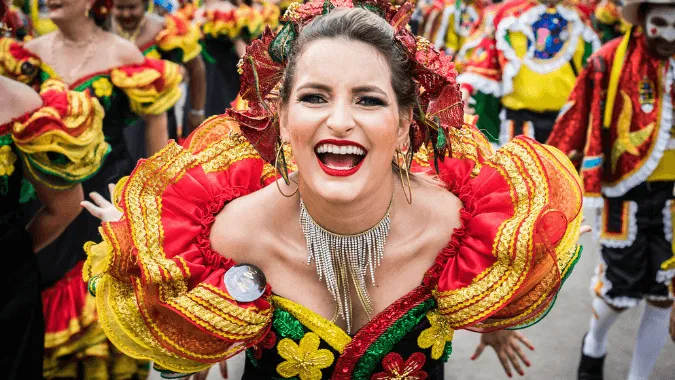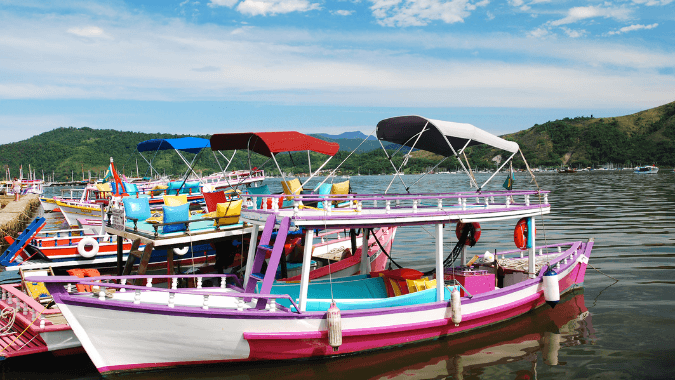Argentina
Argentine Folklore Music – The alternative to Tango
Tags:
folkloric music argentina
folkloric music salta argentina
Argentina has an extremely rich musical culture, but hang on…we’re not talking about Tango! The so called musica folklórica, Argentina’s traditional folkloric musicand dancing is hugely popular throughout the country. Argentineans of all ages have great respect for this integral part of their country’s heritage. Traditional folklore singers sell out jam-packed stadiums – just as any popular music performer would - and most kids grow up learning traditional folkloric dances. It has a strong heritage that stays true to Argentina’s native and indigenous traditions while over many centuries incorporating European and even African influences. Many Eastern European characteristics can be spotted in its rhythms, however the greatest cultural influence comes from Argentina’s Andean regions and its neighbours Bolivia and Paraguay. Folklore music is overtly present in the more rural provinces of Argentina. It could be considered the countryside’s equivalent to the urban folklore; the tango. [caption id="attachment_414" align="alignnone" width="540"]![]() wiphala native people's flag / source: Daytours4u[/caption] Although you can get a taste for Argentina’s folkloric music and dancing in almost every part of the country, it is most widespread in the North, in provinces such as Salta and Jujuy and in coastal provinces such as Entre Rios, Corrientes and Misiones. If you’re travelling to Argentina and want to get a taste for this beautiful aspect of Argentine culture, the best way, is to enjoy a spectacular show at a so-called Peña Folklórica – an Argentine folklore party. If you’re travelling to Salta in the North of Argentina, you’re in luck as you can find some of the most authentic and traditional Peñas in Argentina. At a peña you can enjoy live folklore music and dancing and it goes without saying – always accompanied by wine and great traditional food. However if you’re not travelling to the North, don’t worry as in most large cities, you’ll be sure to find a folklore show. Buenos Aires for example has an array of great folklore clubs. Also most Buenos Aires tango shows, tend to give you a taster of folklore music and dedicate an interval of the show to traditional folklore musicians and dancers. [caption id="attachment_85" align="alignnone" width="378"]
wiphala native people's flag / source: Daytours4u[/caption] Although you can get a taste for Argentina’s folkloric music and dancing in almost every part of the country, it is most widespread in the North, in provinces such as Salta and Jujuy and in coastal provinces such as Entre Rios, Corrientes and Misiones. If you’re travelling to Argentina and want to get a taste for this beautiful aspect of Argentine culture, the best way, is to enjoy a spectacular show at a so-called Peña Folklórica – an Argentine folklore party. If you’re travelling to Salta in the North of Argentina, you’re in luck as you can find some of the most authentic and traditional Peñas in Argentina. At a peña you can enjoy live folklore music and dancing and it goes without saying – always accompanied by wine and great traditional food. However if you’re not travelling to the North, don’t worry as in most large cities, you’ll be sure to find a folklore show. Buenos Aires for example has an array of great folklore clubs. Also most Buenos Aires tango shows, tend to give you a taster of folklore music and dedicate an interval of the show to traditional folklore musicians and dancers. [caption id="attachment_85" align="alignnone" width="378"]![]() A couple dancing the Chacarera. / source: Daytours4u[/caption] There’s a huge variety of folklore styles, all created by Argentina’s gauchos and other rural workers, with their biggest inspiration coming from the land and the agriculture. Being a country with a rich diversity of natural landscapes, Argentina’s folklore traditions obviously differ considerably, depending on which region you’re visiting, each representing their very own, unique characteristics. For example in the Province of Mendoza, Argentina’s wine region, folklore singers tell stories about vineyards and the process of wine making. Or in Corrientes a province in the Northeast, crisscrossed with rivers there’s a specific folklore dance step known as the ‘canoera’ (canoeing). Even though, there are many variations, some of the most popular styles and ones you’ll be sure to come across on your travels to Argentina, are the Chamame, Chacarera and Malambo (or Zapateo). Chamame is a typical style that originates in Paraguay and the Northeast of Argentina in provinces on the banks of the River Parana. The origin is mainly Guaraní, mixed with the Spanish guitar and the European accordion brought to Argentina by immigrants at the beginning of the 20th century. It’s danced in couples, much like a quicker version of the waltz. [caption id="attachment_416" align="alignnone" width="540"]
A couple dancing the Chacarera. / source: Daytours4u[/caption] There’s a huge variety of folklore styles, all created by Argentina’s gauchos and other rural workers, with their biggest inspiration coming from the land and the agriculture. Being a country with a rich diversity of natural landscapes, Argentina’s folklore traditions obviously differ considerably, depending on which region you’re visiting, each representing their very own, unique characteristics. For example in the Province of Mendoza, Argentina’s wine region, folklore singers tell stories about vineyards and the process of wine making. Or in Corrientes a province in the Northeast, crisscrossed with rivers there’s a specific folklore dance step known as the ‘canoera’ (canoeing). Even though, there are many variations, some of the most popular styles and ones you’ll be sure to come across on your travels to Argentina, are the Chamame, Chacarera and Malambo (or Zapateo). Chamame is a typical style that originates in Paraguay and the Northeast of Argentina in provinces on the banks of the River Parana. The origin is mainly Guaraní, mixed with the Spanish guitar and the European accordion brought to Argentina by immigrants at the beginning of the 20th century. It’s danced in couples, much like a quicker version of the waltz. [caption id="attachment_416" align="alignnone" width="540"]![]() Chamame Dancers / source: Daytours4u[/caption] Chacarera is typical in the Northern region of the country, in the Provinces of Santiago del Estero and Salta. Chacareras are generally sung, in both Spanish and native Qechua language. Its dance is in pairs, with couples circling around each other, the male dancers seducing their female partners with foot stomping and handkerchief waving. (see video below) [caption id="attachment_417" align="alignnone" width="540"]
Chamame Dancers / source: Daytours4u[/caption] Chacarera is typical in the Northern region of the country, in the Provinces of Santiago del Estero and Salta. Chacareras are generally sung, in both Spanish and native Qechua language. Its dance is in pairs, with couples circling around each other, the male dancers seducing their female partners with foot stomping and handkerchief waving. (see video below) [caption id="attachment_417" align="alignnone" width="540"]![Chacarera]() Chacarera / source: Daytours4u[/caption] The Malambo is a typical dance that originated in the Pampas region and is carried out by men who display their ability through their footwork and their skill with knives and boleadoras (a kind of cowboy lasso used by the Patagonia natives and gauchos). The Zapateo(or shoe tapping) is a big part of it. A tradition rooted in the Spanish flamenco was a hugely popular past time especially around the camp fires in the lonely stretches of the flatlands known as the Pampas. It was used as a form of competition between two or more men, the competition ending when one of the men is unable to copy the other. Have a look at the incredible video below: footage of a Zapateo competition in the 1920's in the North of Argentina. [caption id="attachment_419" align="alignnone" width="540"]
Chacarera / source: Daytours4u[/caption] The Malambo is a typical dance that originated in the Pampas region and is carried out by men who display their ability through their footwork and their skill with knives and boleadoras (a kind of cowboy lasso used by the Patagonia natives and gauchos). The Zapateo(or shoe tapping) is a big part of it. A tradition rooted in the Spanish flamenco was a hugely popular past time especially around the camp fires in the lonely stretches of the flatlands known as the Pampas. It was used as a form of competition between two or more men, the competition ending when one of the men is unable to copy the other. Have a look at the incredible video below: footage of a Zapateo competition in the 1920's in the North of Argentina. [caption id="attachment_419" align="alignnone" width="540"]![Malambo]() Malambo / source: Daytours4u[/caption] When travelling to Argentina, be sure not to miss out on this fascinating aspect of South American culture! Explore the music of Argentina’s countryside and the gauchos and witness that there's so much more to Argentine music than Tango!
Malambo / source: Daytours4u[/caption] When travelling to Argentina, be sure not to miss out on this fascinating aspect of South American culture! Explore the music of Argentina’s countryside and the gauchos and witness that there's so much more to Argentine music than Tango!
 wiphala native people's flag / source: Daytours4u[/caption] Although you can get a taste for Argentina’s folkloric music and dancing in almost every part of the country, it is most widespread in the North, in provinces such as Salta and Jujuy and in coastal provinces such as Entre Rios, Corrientes and Misiones. If you’re travelling to Argentina and want to get a taste for this beautiful aspect of Argentine culture, the best way, is to enjoy a spectacular show at a so-called Peña Folklórica – an Argentine folklore party. If you’re travelling to Salta in the North of Argentina, you’re in luck as you can find some of the most authentic and traditional Peñas in Argentina. At a peña you can enjoy live folklore music and dancing and it goes without saying – always accompanied by wine and great traditional food. However if you’re not travelling to the North, don’t worry as in most large cities, you’ll be sure to find a folklore show. Buenos Aires for example has an array of great folklore clubs. Also most Buenos Aires tango shows, tend to give you a taster of folklore music and dedicate an interval of the show to traditional folklore musicians and dancers. [caption id="attachment_85" align="alignnone" width="378"]
wiphala native people's flag / source: Daytours4u[/caption] Although you can get a taste for Argentina’s folkloric music and dancing in almost every part of the country, it is most widespread in the North, in provinces such as Salta and Jujuy and in coastal provinces such as Entre Rios, Corrientes and Misiones. If you’re travelling to Argentina and want to get a taste for this beautiful aspect of Argentine culture, the best way, is to enjoy a spectacular show at a so-called Peña Folklórica – an Argentine folklore party. If you’re travelling to Salta in the North of Argentina, you’re in luck as you can find some of the most authentic and traditional Peñas in Argentina. At a peña you can enjoy live folklore music and dancing and it goes without saying – always accompanied by wine and great traditional food. However if you’re not travelling to the North, don’t worry as in most large cities, you’ll be sure to find a folklore show. Buenos Aires for example has an array of great folklore clubs. Also most Buenos Aires tango shows, tend to give you a taster of folklore music and dedicate an interval of the show to traditional folklore musicians and dancers. [caption id="attachment_85" align="alignnone" width="378"] A couple dancing the Chacarera. / source: Daytours4u[/caption] There’s a huge variety of folklore styles, all created by Argentina’s gauchos and other rural workers, with their biggest inspiration coming from the land and the agriculture. Being a country with a rich diversity of natural landscapes, Argentina’s folklore traditions obviously differ considerably, depending on which region you’re visiting, each representing their very own, unique characteristics. For example in the Province of Mendoza, Argentina’s wine region, folklore singers tell stories about vineyards and the process of wine making. Or in Corrientes a province in the Northeast, crisscrossed with rivers there’s a specific folklore dance step known as the ‘canoera’ (canoeing). Even though, there are many variations, some of the most popular styles and ones you’ll be sure to come across on your travels to Argentina, are the Chamame, Chacarera and Malambo (or Zapateo). Chamame is a typical style that originates in Paraguay and the Northeast of Argentina in provinces on the banks of the River Parana. The origin is mainly Guaraní, mixed with the Spanish guitar and the European accordion brought to Argentina by immigrants at the beginning of the 20th century. It’s danced in couples, much like a quicker version of the waltz. [caption id="attachment_416" align="alignnone" width="540"]
A couple dancing the Chacarera. / source: Daytours4u[/caption] There’s a huge variety of folklore styles, all created by Argentina’s gauchos and other rural workers, with their biggest inspiration coming from the land and the agriculture. Being a country with a rich diversity of natural landscapes, Argentina’s folklore traditions obviously differ considerably, depending on which region you’re visiting, each representing their very own, unique characteristics. For example in the Province of Mendoza, Argentina’s wine region, folklore singers tell stories about vineyards and the process of wine making. Or in Corrientes a province in the Northeast, crisscrossed with rivers there’s a specific folklore dance step known as the ‘canoera’ (canoeing). Even though, there are many variations, some of the most popular styles and ones you’ll be sure to come across on your travels to Argentina, are the Chamame, Chacarera and Malambo (or Zapateo). Chamame is a typical style that originates in Paraguay and the Northeast of Argentina in provinces on the banks of the River Parana. The origin is mainly Guaraní, mixed with the Spanish guitar and the European accordion brought to Argentina by immigrants at the beginning of the 20th century. It’s danced in couples, much like a quicker version of the waltz. [caption id="attachment_416" align="alignnone" width="540"] Chamame Dancers / source: Daytours4u[/caption] Chacarera is typical in the Northern region of the country, in the Provinces of Santiago del Estero and Salta. Chacareras are generally sung, in both Spanish and native Qechua language. Its dance is in pairs, with couples circling around each other, the male dancers seducing their female partners with foot stomping and handkerchief waving. (see video below) [caption id="attachment_417" align="alignnone" width="540"]
Chamame Dancers / source: Daytours4u[/caption] Chacarera is typical in the Northern region of the country, in the Provinces of Santiago del Estero and Salta. Chacareras are generally sung, in both Spanish and native Qechua language. Its dance is in pairs, with couples circling around each other, the male dancers seducing their female partners with foot stomping and handkerchief waving. (see video below) [caption id="attachment_417" align="alignnone" width="540"] Chacarera / source: Daytours4u[/caption] The Malambo is a typical dance that originated in the Pampas region and is carried out by men who display their ability through their footwork and their skill with knives and boleadoras (a kind of cowboy lasso used by the Patagonia natives and gauchos). The Zapateo(or shoe tapping) is a big part of it. A tradition rooted in the Spanish flamenco was a hugely popular past time especially around the camp fires in the lonely stretches of the flatlands known as the Pampas. It was used as a form of competition between two or more men, the competition ending when one of the men is unable to copy the other. Have a look at the incredible video below: footage of a Zapateo competition in the 1920's in the North of Argentina. [caption id="attachment_419" align="alignnone" width="540"]
Chacarera / source: Daytours4u[/caption] The Malambo is a typical dance that originated in the Pampas region and is carried out by men who display their ability through their footwork and their skill with knives and boleadoras (a kind of cowboy lasso used by the Patagonia natives and gauchos). The Zapateo(or shoe tapping) is a big part of it. A tradition rooted in the Spanish flamenco was a hugely popular past time especially around the camp fires in the lonely stretches of the flatlands known as the Pampas. It was used as a form of competition between two or more men, the competition ending when one of the men is unable to copy the other. Have a look at the incredible video below: footage of a Zapateo competition in the 1920's in the North of Argentina. [caption id="attachment_419" align="alignnone" width="540"] Malambo / source: Daytours4u[/caption] When travelling to Argentina, be sure not to miss out on this fascinating aspect of South American culture! Explore the music of Argentina’s countryside and the gauchos and witness that there's so much more to Argentine music than Tango!
Malambo / source: Daytours4u[/caption] When travelling to Argentina, be sure not to miss out on this fascinating aspect of South American culture! Explore the music of Argentina’s countryside and the gauchos and witness that there's so much more to Argentine music than Tango! For more information on travel to Argentina review past entries of our Argentina travel blog, and our website, offering a variety of tours in the home of Folklore, Salta, and the rest of Argentina.
Tags:
folkloric music argentina
folkloric music salta argentina
Search
-
Exciting 4x4 route: São Luís and FortalezafromUS$1,014
-
Vila Gale Mares Resort All InclusivefromUS$100
-
Ecotourism in Chapada DiamantinafromUS$672
-
All inclusive Vila Gelé Cumbuco ResortfromUS$999
-
Full Day Cafayate Tour from SaltafromUS$68
-
Transfer Aeroparque - Buenos AiresfromUS$46
-
-
Transfer Ezeiza - AeroparquefromUS$91
-
-
Excursion to El Chaltén from El CalafatefromUS$153
-
-
-
-
-
-
-
-
-
-
-
Daytours4u © 2012-2019. Use of this website constitutes acceptance of the Terms & Conditions.
Open Chat
Hello, How May I Help You?



